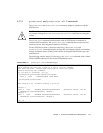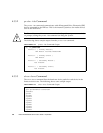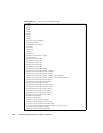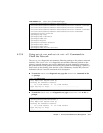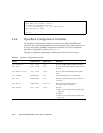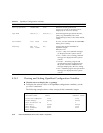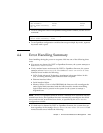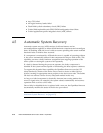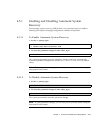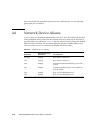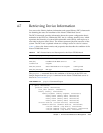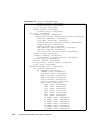
Chapter 4 Firmware and Blade Server Management 4-15
■ To set or change the value of an OpenBoot configuration variable, use the setenv
command:
■ To set OpenBoot configuration variables that accept multiple keywords, separate
keywords with a space.
4.4 Error Handling Summary
Error handling during the power-on sequence falls into one of the following three
cases:
■ If no errors are detected by POST or OpenBoot firmware, the system attempts to
boot if auto-boot? is true.
■ If only nonfatal errors are detected by POST or OpenBoot firmware, the system
attempts to boot if auto-boot? is true and auto-boot-on-error? is true.
Nonfatal errors include the following:
■ SATA (Serial Advanced Technology Attachment) subsystem failure. In this
case, a working alternate path to the boot disk is required.
■ Ethernet interface failure.
■ Serial interface failure.
■ Memory failure. Given a failed FB-DIMM, the firmware will unconfigure the
entire logical bank associated with the failed module. Another non-failing
logical bank must be present in the system for the system to attempt a
degraded boot.
Note – If POST or OpenBoot firmware detects a nonfatal error associated with the
normal boot device, the OpenBoot firmware automatically unconfigures the failed
device and tries the next-in-line boot device, as specified by the boot-device
configuration variable.
■ If a fatal error is detected by POST or OpenBoot firmware, the system does not
boot regardless of the settings of auto-boot? or auto-boot-on-error?. Fatal
nonrecoverable errors include the following:
boot-device disk net disk net
use-nvramrc? false false
error-reset-recovery boot boot
{0} ok
{0} ok setenv error-reset-recovery none
error-reset-recovery = none



